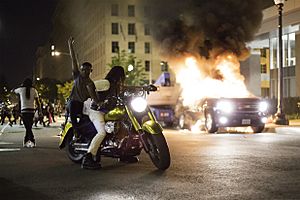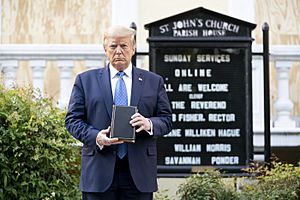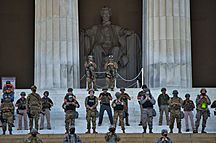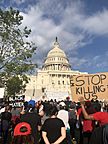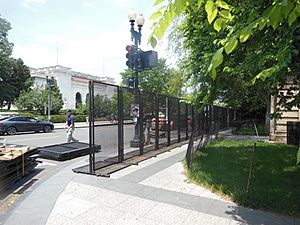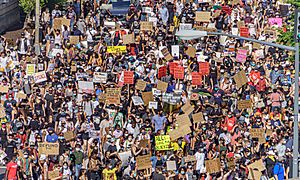George Floyd protests in Washington, D.C. facts for kids
Quick facts for kids George Floyd protests in Washington, D.C. |
|
|---|---|
| Part of George Floyd protests and protests against Donald Trump |
|

Protesters at Lafayette Square on May 30
|
|
| Date | May 28, 2020 – June 23, 2020 (3 weeks, 6 days) |
| Location | |
| Caused by |
|
| Goals |
|
| Methods |
|
Washington, D.C., the capital city of the United States, saw many protests and some unrest. These events happened after the death of George Floyd in Minneapolis. Some of these gatherings involved violence, stealing, and damage to property.
Contents
- Understanding the Protests in Washington, D.C.
- Key Events During the Protests
- Protests Begin: May 29
- Continued Demonstrations: May 30
- Curfew and Looting: May 31
- Clearing Lafayette Square: June 1
- Growing Crowds: June 2
- Peaceful Demonstrations: June 3
- No Curfew: June 4
- "Black Lives Matter Plaza": June 5
- Largest Crowds: June 6
- Continued Peaceful Protests: June 7
- Statue Toppled: June 19
- Attempted Statue Toppling: June 23
- Important Figures at the Protests
- Damage to Monuments and Memorials
- The #dcblackout Hoax
- Key Events During the Protests
- Images for kids
Understanding the Protests in Washington, D.C.
The protests in Washington, D.C., were part of a larger movement across the United States. People were speaking out against police brutality and racial injustice. The events in D.C. often took place near important government buildings.
Key Events During the Protests
The protests in D.C. lasted for several weeks. Here is a timeline of the main events.
Protests Begin: May 29

On May 29, protests started near the White House. The White House was temporarily put on lockdown as protesters gathered. People threw things like bricks and bottles at Secret Service agents. Several agents were hurt.
During this time, President Donald Trump was taken to an underground bunker at the White House. He stayed there for about an hour. His wife and son were also brought to the bunker for safety. The Secret Service later said this happened because the protests were very intense.
President Trump later made comments on Twitter about the protests. He said that if protesters crossed the White House fence, they would face "vicious dogs" and "ominous weapons." He also claimed the protests were "professionally organized." Six people were arrested in Lafayette Square, a park near the White House.
Continued Demonstrations: May 30
Protesters gathered again around the White House on May 30. Some police vehicles were damaged. Words against the President were spray-painted on one vehicle. Important monuments on the National Mall, like the Lincoln Memorial and the World War II Memorial, were also marked with graffiti.
Curfew and Looting: May 31
On May 31, many businesses in areas like CityCenter, Georgetown, and Farragut Square were broken into and looted.
Washington Mayor Muriel Bowser ordered a citywide curfew starting at 11 p.m. Before the curfew, several fires were set. These included attacks at St. John's Episcopal Church near Lafayette Square and at the AFL CIO office building.
A cameraman from BBC News was attacked by police outside the White House. He was filming when an officer with a shield tackled him to the ground.
Clearing Lafayette Square: June 1
Due to the ongoing protests and fires, Mayor Bowser announced a citywide curfew from 7 p.m. to 6 a.m. This curfew lasted until June 3.
Law enforcement officers used tear gas and other methods to clear protesters from Lafayette Square. This happened just minutes before President Donald Trump walked from the White House to St. John's Episcopal Church. Trump held up a Bible for a photo in front of the church, which had been damaged by fire the night before. Many people criticized the clearing of the square. They felt it went against the First Amendment right to protest peacefully.
A local resident, Rahul Dubey, became known for helping protesters. He let over seventy protesters stay in his home when police officers surrounded them. This event was live-streamed and gained a lot of attention online.
Growing Crowds: June 2
On June 2, about 2,000 people protested, which was the largest crowd yet. Senator Elizabeth Warren spoke with the protesters. The main protests were still at Lafayette Square. There was also a march to the Capitol Building.
The President and First Lady visited the Saint John Paul II National Shrine. This visit was criticized by Archbishop Wilton Daniel Gregory, a leader in the Catholic Church in Washington.
More federal law enforcement officers were present. Mayor Muriel Bowser said the city had not asked for this extra help. This day saw less violence compared to previous days.
Peaceful Demonstrations: June 3
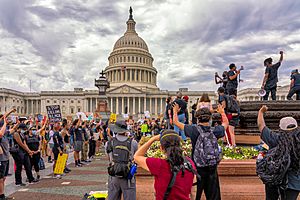
Over 5,000 people took part in peaceful protests across the city on June 3. These protests continued past the curfew into the next morning. No arrests were made, and there were no conflicts with police or damage to property.
Protesters marched through the city, watched by National Guard troops and federal agents. Barricades were set up around certain areas of the capital. Protesters read aloud the names of people who had died in police encounters. They also protested in front of the Capitol building and the Trump International Hotel. In the evening, protesters gathered in Lafayette Park. Some lay down on Pennsylvania Avenue for about eight minutes, chanting, "I can't breathe."
Attorney General William Barr said he would send many law enforcement agents to D.C. These officers came from various federal agencies. Many of them wore uniforms without name badges or agency symbols.
No Curfew: June 4
Thursday, June 4, was the first day without a curfew since Sunday. The protests were peaceful, and D.C. police made no arrests.
Hundreds of protesters gathered peacefully at the Lincoln Memorial. They knelt with raised fists. A large "die-in" was held for over eight minutes at the Martin Luther King Jr. Memorial. A thunderstorm later dispersed protesters near the White House. Two National Guardsmen were injured by a lightning strike, but not seriously.
"Black Lives Matter Plaza": June 5
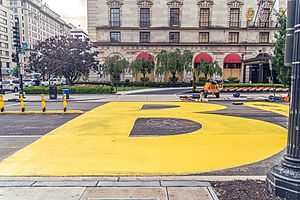
On June 5, artists painted the words "Black Lives Matter" in large letters on 16th Street NW. This street leads to the White House and Lafayette Square. The city government helped with this project. This section of the street was given the honorary name Black Lives Matter Plaza.
Mayor Bowser asked President Trump to remove all extra law enforcement and military from D.C. She noted that the protests had been peaceful. The Pentagon later announced it was removing 1,600 active-duty troops from near the city.
Largest Crowds: June 6
On Saturday, June 6, over 10,000 people demonstrated. This was the largest protest in the city so far. Senators Mitt Romney and Elizabeth Warren, and Representative John Lewis, were among the protesters. The largest gatherings were near the White House. Other groups gathered at places like 14th & U Street and the Lincoln Memorial.
Law enforcement presence was greatly reduced. The atmosphere felt more like a "block party" or "festival" than a tense protest. Some individuals spray-painted "Defund the Police" on the street. This was done to criticize Mayor Bowser, who also spoke at the protests. Police reported one arrest for property damage.
Continued Peaceful Protests: June 7
Protests continued peacefully on Sunday, June 7. The atmosphere was described as less tense than in previous days. President Trump tweeted that he had ordered the National Guard to leave.
Statue Toppled: June 19
On Juneteenth, protesters gathered at the Albert Pike Memorial in Judiciary Square. They used ropes and chains to pull down the statue of Pike. The statue was then set on fire. Local police put out the flames. The National Park Service removed the statue the next day. President Trump tweeted about the incident, saying the D.C. police were not doing their job. However, the statue was in a federal park, so it was under federal police control, not local D.C. police.
Attempted Statue Toppling: June 23
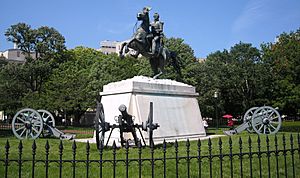
Hundreds of protesters gathered near the statue of Andrew Jackson in Lafayette Square. Protesters spray-painted words on the statue's base. Some tried to pull the statue down with ropes but were unsuccessful. Police used batons and pepper spray to break up the crowd.
Later, the United States Department of Justice (DOJ) announced that four men were charged with damaging federal property for trying to pull down the statue. The DOJ also announced the arrest of a man who was seen climbing the Jackson statue and helping to pull down the Albert Pike statue on June 20.
Important Figures at the Protests
Several well-known politicians joined the protests. Senator Elizabeth Warren appeared on June 2. Senator Kamala Harris visited Black Lives Matter Plaza on June 5. Congressman John Lewis, a famous civil rights leader, visited Black Lives Matter Plaza on June 7. He said it was "very moving."
Senator Mitt Romney was the first Republican senator known to join the protests. He attended a rally and a march on June 7. He said, "We need many voices against racism and against brutality. We need to stand up and say that black lives matter." His participation was similar to his father's involvement in the Civil Rights Movement in the 1960s.
Damage to Monuments and Memorials
During the protests, some monuments and memorials in Washington, D.C., were damaged. These included the Lincoln Memorial, the World War II Memorial, and the statue of General Casimir Pulaski.
The statue of Mahatma Gandhi, a leader of India's independence movement, was also vandalized. The Indian Embassy complained to law enforcement. The Indian Ambassador called it "a crime against humanity." U.S. President Donald Trump also called the damage to Gandhi's statue a "disgrace."
The #dcblackout Hoax
The #dcblackout hoax was a false story spread widely online during the 2020 George Floyd protests. This hoax claimed that the U.S. government had shut down all communication channels in Washington, D.C. Some posts even showed fake images of the Washington Monument on fire.
NPR described the hoax as "well funded and well organized." Experts suggested it might have been a "classic Russian move" to spread false information. The BBC reported that many of the most shared posts came from users outside Washington D.C. or even outside the U.S. Twitter suspended hundreds of accounts that were spreading this hashtag.
Images for kids


